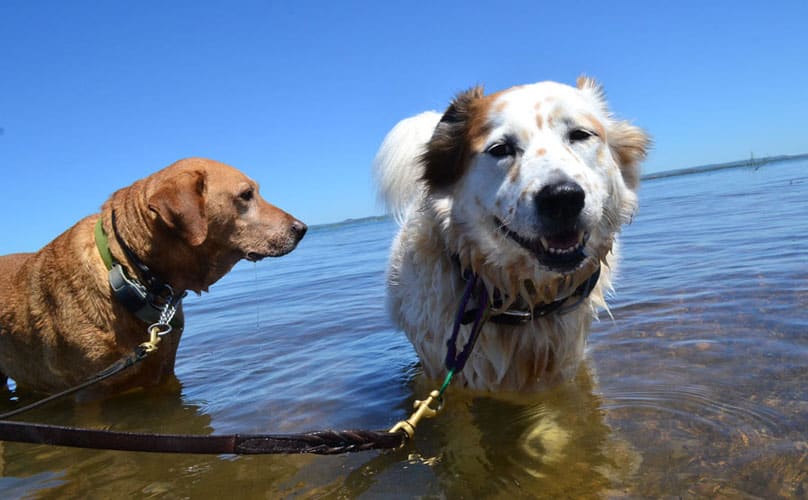
We've been lucky so far this spring…although the temperatures are already flirting with the 90s, we haven't had any hot, hot days.
Yet.
Living in Texas, hot weather is just a fact of life for at least four months of of the year. We'll soon be approaching triple digits, and the high temps will remain into September.
We adjust our days around the weather. The morning walk takes place earlier and it becomes our longest walk of the day. The evening walk, taken before dinner during the cooler months, shifts to after dinner. Even then, temperatures can remain toasty so evenings mean a shorter walk.
Today is National Heat Awareness Day (who knew?!), and we just received some handy tips from the Texas Veterinary Medical Association (TVMA) reminding pet owners that intervening at the first sign of their pet overheating is the key to preventing a serious emergency. Asphalt and concrete become griddles during hot weather and, even if they're cool enough for your dog to walk on safely (and many times they're not), the heat coming up off those surfaces can be very taxing on your dog, especially smaller dogs whose bodies are closer to the hot surface.
Please take a moment to read the TVMA's tips on preventing heatstroke before you begin your summer fun in a few weeks:
Heatstroke occurs when a pet's normal body mechanisms cannot keep the body's temperature within a safe range. Considered a veterinary emergency, heatstroke can result in gastrointestinal upset, dysfunction of internal organs, internal bleeding, infection or even death in severe cases. It's up to pet owners to exercise caution to avoid heatstroke and seek veterinary care when their pet shows signs of overheating.
Signs of heatstroke in dogs include rapid breathing, a bright red tongue, red or pale gums, thickened saliva, depression, a refusal to walk, diarrhea and stumbling or staggering. In cats, the signs of heatstroke include restlessness, drooling, vomiting, lethargy and panting.
“Don't depend on your pet to let you know when they are overheating,” said Christine New, DVM, a TVMA member who practices at Hillside Veterinary Clinic in Dallas. “At the early stages of overheating, intervention by pet owners can prevent mild overheating from progressing to heatstroke, which is a serious, sometimes fatal condition.”
Pets are unable to sweat, which means they don't have the efficient cooling system the human body does. This also means that the effects of heat are felt much more strongly and much more quickly in pets than in humans, so it's up to pet owners to take steps to keep their pets' bodies in a safe temperature range.
Steps you can take to prevent heatstroke during periods of warm weather include:
- Never leave your pet in your car, even for a short period of time. Heatstroke can occur when a pet is left in a car even on a 70-degree day.
- Make sure your pet has access to shade and an ample amount of water while outside.
- Create a cooling source for your pet, like a kiddie pool filled with cool (not ice) water, or allow your pet to lie on bottles or sealed bags filled with water that are wrapped in a towel.
- Avoid exercising or walking your pet at peak temperature hours or on especially hot or humid days. A good rule of thumb is that pets are at risk for heatstroke once the outside temperature hits at least 80 degrees and a humidity of at least 90 percent.
If you think your pet is experiencing heatstroke, move your pet to a cool or shaded area immediately. Try to cool your pet's body by wetting it with cool water and exposing it to a breeze or a nearby fan. Make water available but do not force your pet to drink. Transport your pet to the nearest veterinary facility for treatment. The effects of heatstroke are often subtle and not immediately apparent. Even if your pet appears to have recovered, it's possible that they are still at risk for the damaging effects of heatstroke.
For more information on heatstroke, visit www.texvetpets.org/article/heatstroke-heat-can-be-fatal-to-your-pet. To download a colorful and informational poster about how to spot and prevent heatstroke, visit www.texvetpets.org//wp-content/uploads/2014/07/well-14-new-heatstroke-poster.pdf.

No comments:
Post a Comment